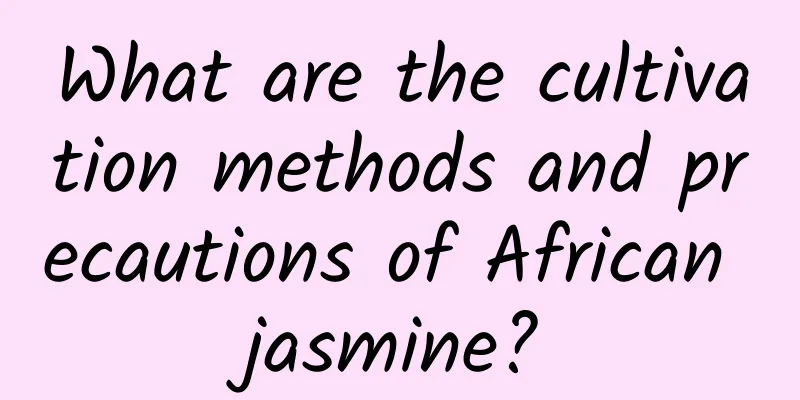What are the cultivation methods and precautions of African jasmine?

African Jasmine IntroductionAfrican jasmine is a plant of the genus African jasmine in the Loganaceae family. Its original name is Chinese African jasmine, and its aliases include African African jasmine, African African jasmine fruit, etc. Generally, the ripe fruits of African jasmine are collected between October and December, and then sown for propagation. The seedlings will not emerge until the spring of the following year. They can also be propagated by cuttings during the rainy season from June to July. African jasmine cultivation methodAfrican jasmine likes an environment with plenty of sunlight, but needs to avoid exposure to strong sunlight in summer. It likes an environment with high air humidity and good ventilation. It is not cold-resistant. The suitable growth temperature is between 18-32 degrees, not higher than 38 degrees or lower than 0 degrees. It grows best in loose, fertile, well-drained loam. Watering methodAfrican jasmine likes a humid environment and has a high demand for water in summer. If it is not watered in time, the new shoots will wilt and droop. At this time, do not rush to water it, but spray some water on the leaves first, wait until it recovers, and then water the potting soil with an appropriate amount of water. Fertilization methodDuring the growth period of African jasmine, apply a thin layer of cake fertilizer water every half a month. Apply phosphorus and potassium fertilizers before flowering in May to promote flower bud differentiation. After autumn, apply phosphorus and potassium fertilizers 1-2 times to ensure a safe winter. If potted in the northern region, add 0.2% ferrous sulfate. Pruning methodsAfrican jasmine can have its branches pruned short, and dead, diseased, and thin branches can be cut off in time during the growth period. When repotting every year, the roots can be trimmed and new culture soil can be replaced. After pruning, the number of waterings can be reduced. African jasmine cultivation precautionsAfrican jasmine is prone to anthracnose, which affects the growth of leaves and tenderer branches. If left untreated, the entire plant may even die. It needs to be controlled with carbendazim. Common pests are the short-fronted locusts, which reproduce quickly and cause greater damage. They can be eliminated with dichlorodiphenyltrichloroethane. |
<<: What are the cultivation methods and precautions for large potted green radish?
>>: What are the cultivation methods and precautions of perilla
Recommend
Is Gypsophila easy to grow? How to grow Gypsophila and when is the best time to grow it?
As one of the top ten cut flowers in the world, b...
When is the best time to sow garlic?
Garlic sowing time Garlic, also known as garlic, ...
Which month is best to plant freesia?
Freesia, also known as freesia, is a perennial bu...
Preparation method of plant rooting agent
Rooting agents are widely used in production and ...
What kind of crop is millet? (Picture)
What kind of crop is millet The original meaning ...
How long does it take for clematis to bloom? How long does it take from germination to flowering?
How long does it take for clematis to bloom? From...
How to propagate purple magnolia
Propagation of Magnolia liliiflora by seeding Pur...
How to make Kirin Palm alive by cuttings? Cutting methods and precautions
Kylin palm can be propagated by sowing and cuttin...
Why has the persimmon tree not borne fruit for two or three years? (The reason why it borne fruit last year but not this year)
There are two persimmon trees in front of my hous...
How to grow garlic to get high yield?
Garlic prefers cool environments and is usually p...
How often should you water roses?
How often should you water your roses? Roses are ...
How to water yew bonsai
Watering tips for yew bonsai The yew tree needs m...
How to grow cinnabar root
Breeding environment temperature Cinnabar root li...
What is the reason for the osmanthus leaves to fall?
Causes of leaf fall 1. Improper planting season O...
Sweet potato growth environment conditions and characteristics
Sweet potato growth environment conditions and re...









